Are tiny bugs buzzing around your home, especially in the kitchen? You might be dealing with flies! While fruit flies are a common culprit, various types of flies can become unwelcome guests in our houses. Fortunately, getting rid of them doesn’t require expensive solutions or harsh chemicals. You likely have everything you need already at home to create effective fly traps and implement preventative measures.
We recently encountered a fruit fly issue at home – a first in a long time! This prompted us to experiment with different methods to eliminate them. After thorough testing and careful observation, we’re sharing the best DIY fly traps and how to make them.
These homemade traps are simple to assemble using natural ingredients you probably already have. They’re also a humane and chemical-free approach to managing flies. Plus, we’ll provide tips on preventing fly infestations in the first place, ensuring these pests don’t become a recurring problem in your home.
Understanding Common House Flies
Flies are small flying insects that are attracted to various things depending on the species. Fruit flies, as their name suggests, are drawn to ripe or fermenting fruits and vegetables. However, flies in general can also be attracted to sugary substances, decaying organic matter, garbage, and even moisture. You might see them buzzing around fruit bowls, trash cans, drains, or even windows. They vary in size, but many common house flies are small, and can appear tan, brownish, or even black. Flies tend to be more prevalent during warmer months when they are more active and breeding cycles are faster.
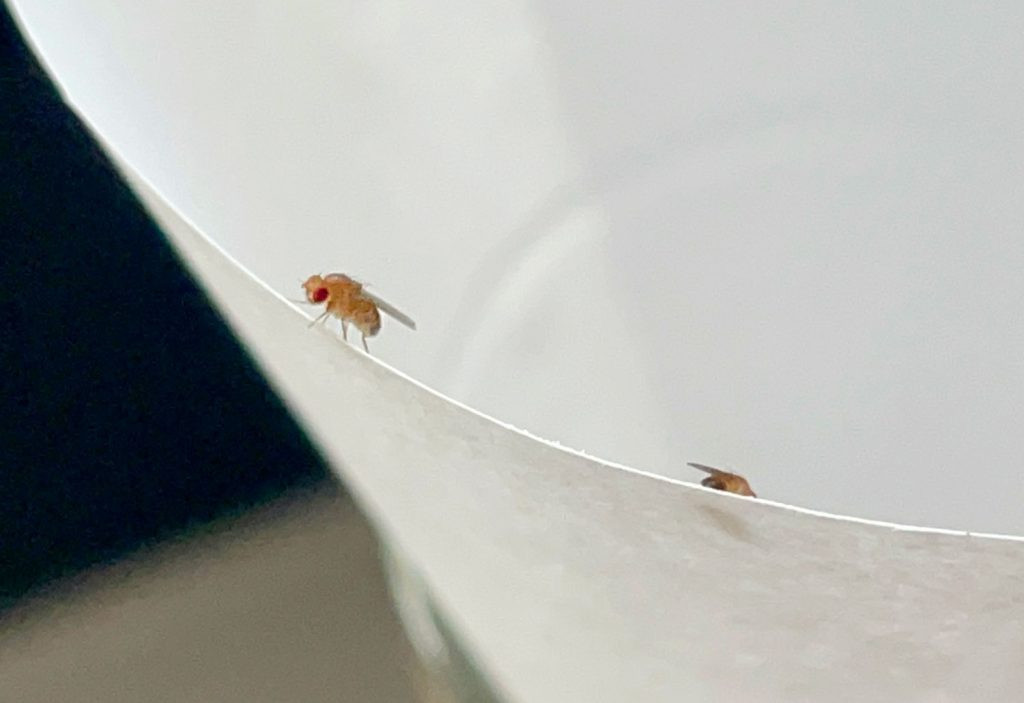 Close Up Of Fruit Fly On Paper Funnel
Close Up Of Fruit Fly On Paper Funnel
A fly problem can start with just a few individuals entering your home. However, flies, especially fruit flies, reproduce rapidly. Females can lay hundreds of eggs, and these eggs can hatch in as little as 12 hours. The life cycle from egg to adult can be completed in just a few days, meaning a small number of flies can quickly escalate into a significant infestation. This rapid reproduction is why addressing a fly problem quickly is essential.
Identifying Common House Flies: Fruit Flies, Fungus Gnats, and Drain Flies
It’s easy to mistake different small flying insects for one another. Fruit flies are often confused with fungus gnats and drain flies. Correctly identifying the type of fly you’re dealing with is helpful for targeting your removal efforts effectively. The easiest way to distinguish them is by where you see them and what they physically resemble.
- Fruit flies look like small flies. As mentioned, they are typically found near fruit bowls, garbage, spilled drinks, or any fermenting food source.
- Drain flies look like small fuzzy moths. They are usually spotted near sinks, drains, and damp areas, as they breed in the organic matter that accumulates in drains.
- Fungus gnats look like small mosquitos. These are commonly found near houseplants, as they thrive in damp potting soil and feed on fungus in the soil.
If you’re unsure what type of fly you have, trying one of the general fly traps described below can be a good diagnostic tool. If it attracts the pests in your home, you’re likely dealing with fruit flies or a similar type of small house fly attracted to sweet or fermenting substances.
4 Simple DIY Fly Traps for Your Home
Getting rid of flies in your house doesn’t have to be complicated or break the bank. You likely have common household items that can be turned into effective fly traps. Each of these traps operates on a simple principle: attract the flies and then prevent their escape. We tested the following 4 DIY methods and found a clear winner among them. Since each method uses items you probably already have, trying more than one is easy and can increase your success. Think of it as a little home science experiment! Here are 4 easy methods to try:
- Funnel Trap
- Plastic Wrap Trap
- Dish Soap Trap
- Rotting Fruit Trap
We’ll provide details on each method below and share our findings on their effectiveness. Keep in mind that some traps work faster than others, and it may take a few days to significantly reduce or eliminate your fly problem. Patience is key!
#1: The Paper Funnel Fly Trap
This trap design uses a paper funnel to guide flies into a container baited with an attractant. The narrow opening at the bottom of the funnel makes it easy for flies to enter but difficult for them to find their way back out.
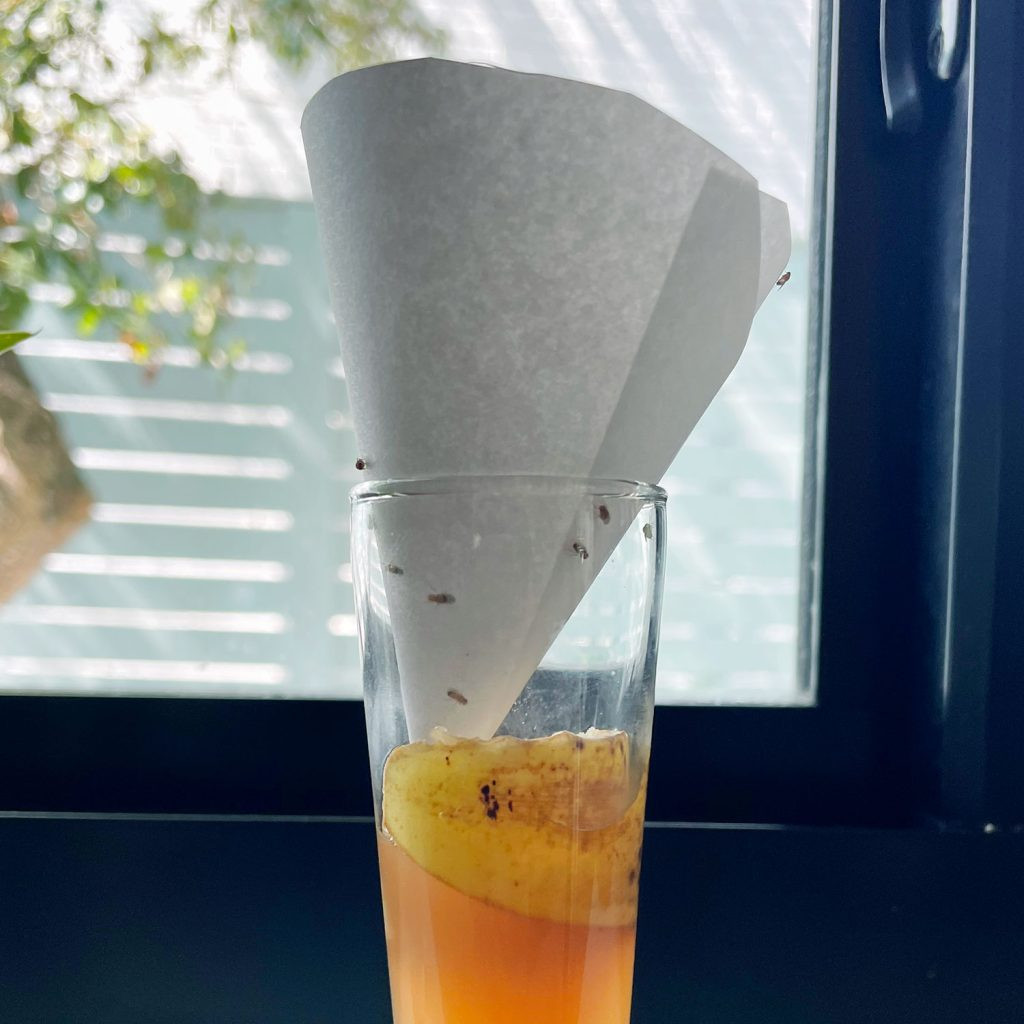 DIY Fruit Fly Trap With Paper Funnel
DIY Fruit Fly Trap With Paper Funnel
Materials You’ll Need:
- A small, clear jar, cup, or container. A narrow opening is beneficial for this method.
- A sheet of paper or cardstock.
- Tape.
- Scissors.
- Apple cider vinegar (ACV), or other liquid attractant like wine or beer.
Instructions:
- Choose Your Trap Container: Select a small, clear container such as a clean food jar or a plastic bottle. A clear container helps you monitor the trap’s success. A narrower opening is ideal for preventing escapes.
- Add the Attractant: Pour a small amount of apple cider vinegar, old beer, or wine into the bottom of the container. These liquids are attractive to fruit flies and many other types of house flies.
- Create the Paper Funnel: Roll a piece of paper or cardstock into a cone shape. The key is to create a very small opening at the pointed end of the cone – about the size of a grain of rice. Secure the cone shape with tape. You can create the small opening either while rolling the cone or by cutting the tip after taping.
- Set Up the Funnel in the Container: Place the paper cone into the opening of your container, with the narrow opening pointing down into the container. You might need to adjust the funnel’s width so it rests securely on the container’s rim without touching the liquid attractant. Ensure the funnel fits snugly against the edges of the opening to prevent flies from escaping through gaps.
- Humane Release Option (Optional): If you prefer to release the trapped flies outdoors, carefully carry the entire trap outside without disturbing the funnel too much (or the flies might escape). Once outside, remove the funnel to allow the flies to fly away.
While you can use a store-bought funnel, homemade paper funnels often work better because you can customize the size of the bottom opening to be very small, maximizing the trap’s effectiveness.
#2: The Plastic Wrap Fly Trap
Similar to the funnel trap, this method uses an attractant to lure flies into a container, but it uses plastic wrap with small holes as the barrier to prevent escape.
Materials You’ll Need:
- Small, clear jar, cup, or container.
- Rubber band.
- Plastic wrap or a plastic bag.
- Toothpick.
- Apple cider vinegar (ACV), or other liquid attractant.
Instructions:
- Choose Your Container: Select a small, clear jar, cup, or glass container. Almost any size container will work. Using a clear container makes it easy to see how many flies you’re trapping. You can even repurpose an old can or bottle.
- Add the Attractant: Pour apple cider vinegar into the container. The sweet, fermented scent is highly attractive to flies. Old beer or wine are also effective alternatives. Regular white vinegar is not as attractive to flies.
- Cover the Opening with Plastic Wrap: Stretch plastic wrap tightly over the opening of the container and secure it firmly with a rubber band around the rim. Make sure there are no loose edges or gaps. You can use standard kitchen plastic wrap, or even cut a piece from a plastic bag.
- Poke Small Entry Holes: Use a toothpick to gently poke a few small holes in the plastic wrap covering. These holes should be just large enough for flies to enter. You don’t need many holes – just a few strategically placed openings will work.
- Humane Release Option (Optional): To release the trapped flies outside, carefully move the entire trap outdoors, ensuring the plastic wrap remains in place. Once outside, remove the plastic wrap to allow the flies to escape.
Alternatively, you can adapt this method using a metal lid from a jar. Puncture a small hole in the metal lid using a hammer and nail, then screw the lid onto the jar after adding the attractant.
#3: The Dish Soap Fly Trap
This trap is even simpler than the previous two, as it doesn’t require creating a physical barrier. Instead, it uses dish soap to reduce the surface tension of the liquid attractant. Flies are drawn to the scent, but when they land on the soapy surface, they become trapped and sink. Note: This method is not designed for humane release as the soap is intended to trap and eliminate the flies.
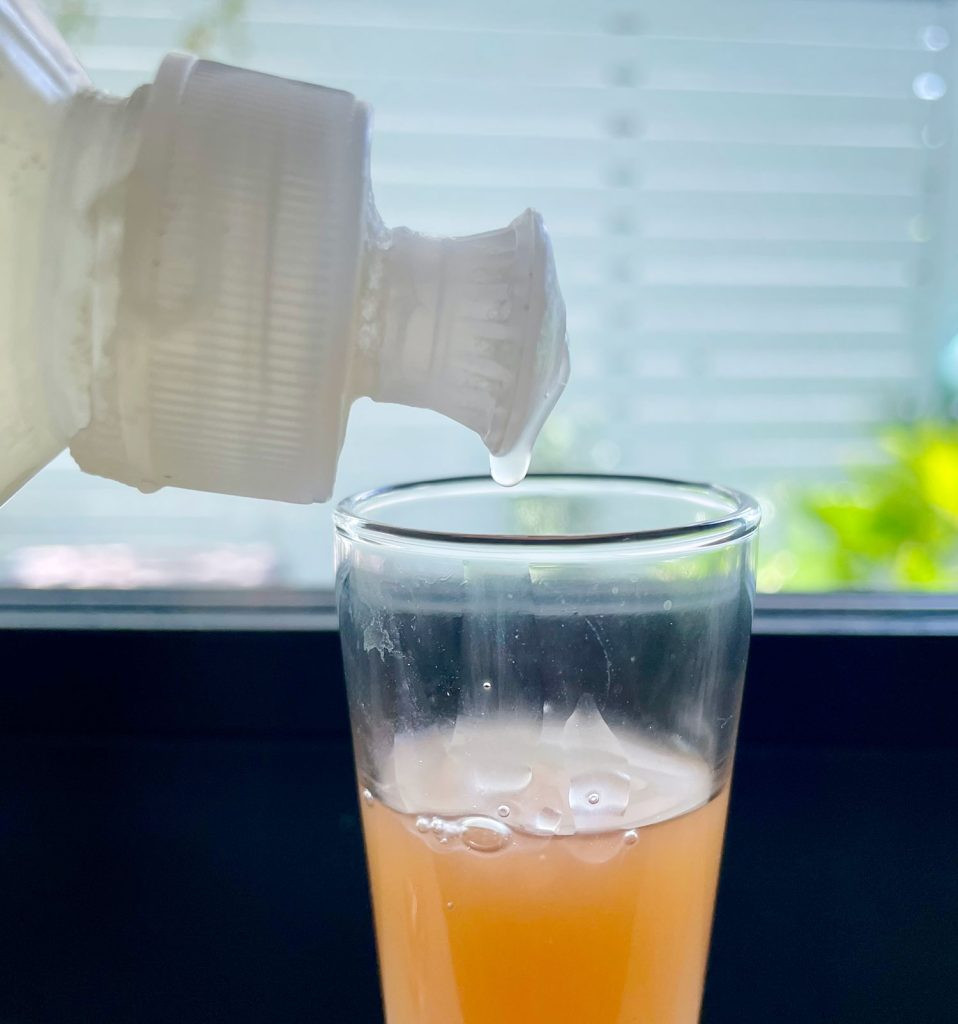 Dripping Dish Soap Into Apple Cider Vinegar For DIY Fruit Fly Trap
Dripping Dish Soap Into Apple Cider Vinegar For DIY Fruit Fly Trap
Materials You’ll Need:
- A small container, bowl, or dish.
- Dish soap.
- Apple cider vinegar (ACV), or other liquid attractant.
Instructions:
- Pour in the Attractant: Pour a small amount of apple cider vinegar into the bottom of your chosen container – a small bowl, dish, or jar works well. The scent of the vinegar will attract the flies.
- Add Dish Soap and Mix: Add several drops of dish soap to the apple cider vinegar. Gently mix the soap into the vinegar. You don’t need to create bubbles, just ensure the soap is dispersed in the liquid. The soap breaks the surface tension, so flies that land on the mixture will become trapped and drown.
This dish soap method can also be combined with the plastic wrap or funnel traps. Adding dish soap to the apple cider vinegar before covering the container can increase the effectiveness of those traps, providing an additional way to trap the flies if they do manage to enter.
#4: The Rotting Fruit Fly Trap
Flies, especially fruit flies, are strongly attracted to overripe and rotting fruit. This trap leverages that attraction by using actual fruit as bait.
Materials You’ll Need:
- Small glass jar, cup, or container.
- Plastic wrap or paper funnel, depending on which trap style you prefer.
- A small piece of ripe or overripe fruit, such as a banana peel or apple slice.
Instructions:
To create a rotting fruit trap, simply replace the apple cider vinegar in either the Plastic Wrap Trap or the Funnel Trap with a piece of ripe or overripe fruit. Banana peels, apple slices, peach pieces, or other soft fruits work well. You can also combine fruit with apple cider vinegar for a more potent attractant.
Be aware that fruit will decompose and may start to smell if left out for too long. Replace the fruit every day or two to maintain its attractiveness and prevent unpleasant odors in your kitchen.
Finding the Most Effective Fly Trap
To determine the most effective DIY fly trap, we tested four variations, combining different trap types and attractants. The four homemade traps we tested were:
- Plastic Wrap Trap with banana peel
- Funnel Trap with ACV + banana peel
- Plastic Wrap Trap with ACV + dish soap
- Dish Soap Trap with ACV
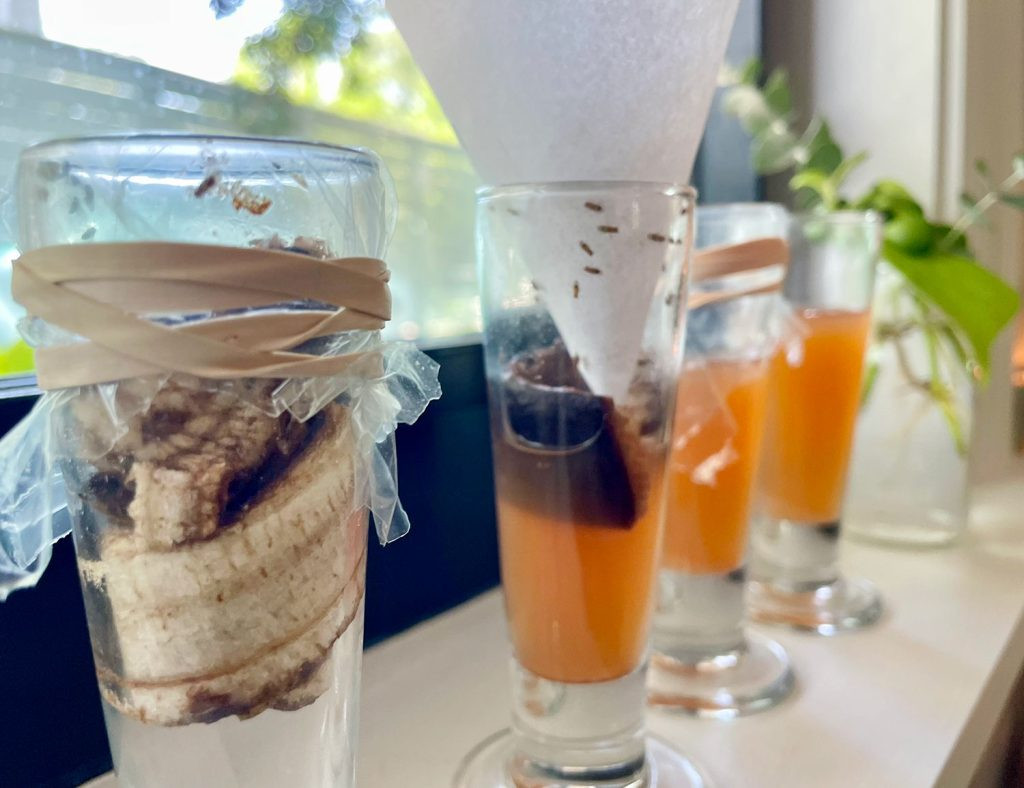 4 DIY Fruit Fly Traps Close Up
4 DIY Fruit Fly Traps Close Up
Our results indicated that the type of attractant was more significant than the trap design. Traps using banana peel as bait were significantly more effective than those using apple cider vinegar alone. The two Plastic Wrap Traps were very similar in design, but the one baited with banana peel caught considerably more flies than the one with ACV and soap. This suggests that while ACV is effective, real fruit is even more enticing to flies, especially when readily available.
Based on our experiment, we recommend using fruit scraps as bait in your fly traps, regardless of the trap style. We slightly preferred the plastic wrap trap because it was simple to make and less prone to accidental spills. We did knock over the funnel trap once, releasing some trapped flies back into the kitchen – oops!
What Bait Attracts Flies the Most?
Intrigued by the success of fruit scraps, we conducted a follow-up experiment to identify the most attractive type of fruit bait. We tested three readily available fruits: banana peel, apple slices, and a strawberry. Each fruit was placed in a separate Plastic Wrap Trap, and we positioned them side-by-side on the counter for 24 hours.
While the banana peel initially seemed promising (it was the ripest at the start), the strawberry ultimately attracted the most flies. The banana peel still caught a good number of flies, but as the strawberry became more fermented, it became increasingly attractive. Interestingly, the apple slices didn’t catch any flies at all in our test!
Store-Bought Fly Traps
If DIY methods aren’t working for you, or if you prefer a ready-made solution, several effective store-bought fly traps are available. These traps often have excellent reviews and are generally affordable. They can be a good option if you want a trap that targets a broader range of flying insects or if you prefer a more discreet appearance compared to DIY traps.
 Collage of Storebought Fruit Fly Traps
Collage of Storebought Fruit Fly Traps
During our experiments, we also tested Terro Fruit Fly Traps to compare their performance against our homemade traps. We placed a Terro trap next to our banana and strawberry traps for 24 hours.
Initially, the homemade strawberry and banana traps outperformed the store-bought trap. The Terro trap caught only a single fly in the first 24 hours, while the DIY traps caught significantly more. HOWEVER…
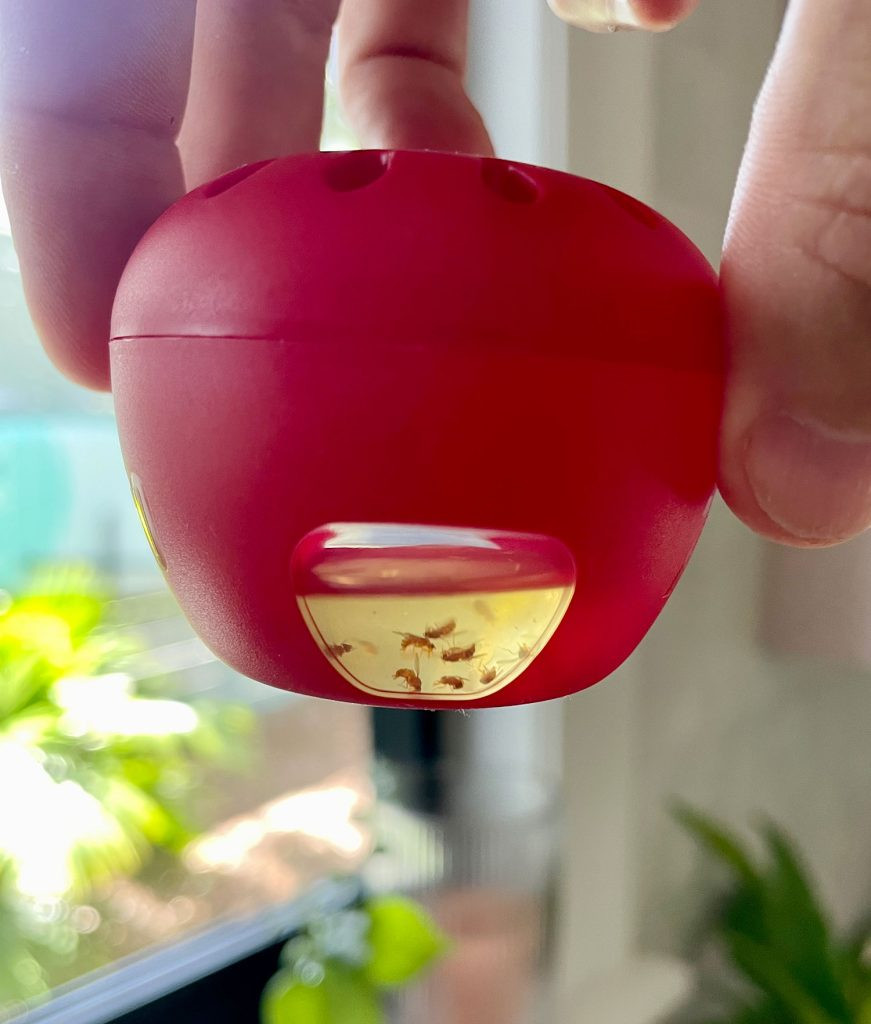 Terro Fruit Fly Trap With Dead Fruit Flies Visible
Terro Fruit Fly Trap With Dead Fruit Flies Visible
To get a complete picture, we removed the DIY traps and left the Terro trap out for another 24 hours. Over this extended period, the Terro trap effectively caught a substantial number of flies, as shown in the photo. So, while our homemade traps worked faster initially, the store-bought trap was also effective over time.
Our conclusion? Store-bought traps are a good choice if you want a more discreet option, especially for long-term placement. However, for fast and immediate results, homemade traps, particularly those baited with fruit, are highly effective for quickly getting rid of flies in your house.
Preventing Flies in Your Home
While trapping flies is effective for reducing their numbers, preventing them from infesting your home in the first place is the best long-term strategy. Here are simple preventative measures to keep flies away:
- Maintain Clean Kitchen Surfaces: Regularly wipe down kitchen counters, stovetops, tables, and any surfaces that might collect food residue or spills. Flies are especially attracted to sugary substances, fruit juices, and alcohol, so prompt cleanup is crucial.
- Take Out Trash Regularly: Food scraps left in your garbage, especially overnight, can quickly become a breeding ground for flies. Empty your trash cans frequently, especially kitchen trash.
- Properly Dispose of Overripe Fruit: Monitor your fruit bowl and discard any fruit that is becoming overripe, bruised, or rotten. These are prime attractants for fruit flies.
- Wash Produce Promptly: Wash fruits and vegetables as soon as you bring them home from the store. This helps remove any fly eggs or larvae that might be present on the surface of the produce (except for berries, which are best washed just before eating to prevent them from becoming mushy).
- Refrigerate Produce When Possible: Flies, especially fruit flies, do not thrive in cold temperatures. Store fruits and vegetables in the refrigerator whenever possible to slow down ripening and deter flies.
- Keep Sink Drains Clean: Food particles and organic matter in sink drains can attract drain flies and fruit flies. Regularly run your garbage disposal and flush drains with hot water or a drain cleaner to remove buildup.
Finally, remember that discovering flies in your home is a common problem and not a cause for panic. While you should take action quickly to prevent the problem from worsening, the solutions outlined here are easy, effective, and fast-acting. You might even enjoy becoming a home fly scientist in the process!
*This post contains affiliate links, so we may earn a small commission when you make a purchase through links on our site at no additional cost to you.